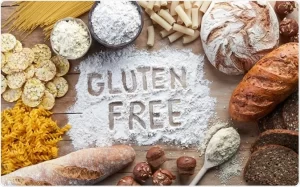Intro
Are you looking to make a positive change in your diet and overall health? Have you considered trying a gluten-free diet but aren't sure where to start? In this beginner's guide, we will explore the ins and outs of a gluten-free diet, including what gluten is, why you might choose to go gluten-free, and how to successfully navigate a gluten-free lifestyle. We will also provide you with a 7-day gluten-free meal plan to help you get started on your journey to a healthier you.
What is Gluten and Why Go Gluten-Free?
Gluten, a protein found primarily in wheat, barley, and rye, serves as a binding agent that gives foods like bread and pasta their shape and texture. It's pervasive in many diets due to its widespread use in a variety of foods, including sauces, dressings, and even some less obvious products such as beauty items. For certain individuals, consuming gluten can trigger health issues ranging from mild discomfort to severe reactions. Specifically, those with celiac disease experience an immune response that damages the lining of the small intestine, leading to nutrient absorption issues and associated health problems. Others may have non-celiac gluten sensitivity, which can cause symptoms like bloating, headaches, and fatigue without the autoimmune response seen in celiac disease.
Opting for a gluten-free diet can offer relief from these symptoms for those affected, contributing to an overall enhancement of health and vitality. Beyond symptom relief, people often report an uptick in energy levels and a reduction in inflammatory responses, aligning with a healthier lifestyle. The decision to eliminate gluten from the diet isn't solely limited to those with a diagnosed condition; some individuals choose this path in pursuit of a dietary change that aligns with wellness goals, such as improved digestive health and increased nutrient absorption. Transitioning to a gluten-free lifestyle involves a careful approach to diet modification, ensuring that the foods selected contribute to a balanced and nutritious dietary intake.
Identifying Gluten in Your Diet
Identifying gluten in your diet is a critical step towards a successful gluten-free lifestyle. Gluten lurks in many products, some obvious and some quite surprising. Beyond the well-known sources like bread, pasta, and cereals made from wheat, barley, and rye, gluten can also be found in less obvious items. These can include certain brands of soy sauce, salad dressings, soups, and even some types of beer. Another unexpected place gluten may hide is in processed foods and condiments, where it acts as a thickener or stabilizer.
The key to avoiding gluten is becoming an adept label reader. Food labels are your best resource for identifying gluten-containing ingredients. Look out for terms such as wheat, barley, malt, brewer's yeast, and rye. However, recognizing gluten on ingredient lists requires some knowledge of its various aliases and forms. Ingredients like bulgur, durum, farro, and spelt, for instance, are types of wheat and thus contain gluten.
Be mindful of cross-contamination as well, especially in products that may not contain gluten themselves but are processed in facilities that handle gluten-containing foods. Products certified as gluten-free are your safest bet, as they meet strict standards for gluten content.
Understanding how to identify gluten in your diet extends to non-food items as well, as gluten can be present in lip balms, toothpastes, and skincare products, potentially affecting those with severe sensitivities or celiac disease. By arming yourself with the knowledge of where gluten may hide, you can make informed choices to protect your health and adhere to a gluten-free diet more effectively.
The Benefits and Challenges of Going Gluten-Free
Embarking on a gluten-free diet presents a multitude of potential health benefits. Many individuals report significant improvements in digestion and a noticeable decrease in bloating and discomfort. The elimination of gluten often leads to increased energy levels, as the body is no longer expending resources to combat the adverse effects of gluten on the system. Additionally, a reduction in inflammation is commonly observed, which can contribute to a feeling of overall well-being and can be particularly beneficial for those with autoimmune conditions or inflammatory diseases.
However, adopting a gluten-free lifestyle is not without its hurdles. One of the primary challenges is the risk of nutritional deficiencies. Gluten-containing grains are a major source of B vitamins, fiber, and iron in many diets. When these are removed without proper substitutes, one might face a shortage of these critical nutrients. Furthermore, the convenience factor decreases when following a gluten-free diet. Finding suitable gluten-free options while dining out or at social events can pose a significant challenge, requiring additional planning and vigilance. There's also the aspect of cost, as many gluten-free products are priced higher than their gluten-containing counterparts.
Understanding and navigating these challenges is crucial for anyone considering a gluten-free diet. It involves more than just avoiding gluten; it's about making informed food choices that ensure a balanced and nutritious diet. This journey, while possibly daunting at first, can lead to a more mindful and healthful approach to eating.
Essential Gluten-Free Foods to Stock Your Pantry With
Creating a gluten-free pantry is the cornerstone of embracing a gluten-free lifestyle. Begin with staples that form the basis of many meals: grains such as quinoa, brown rice, and certified gluten-free oats offer versatility and nutrition. They can serve as the foundation for everything from breakfast porridge to hearty dinner bowls. Additionally, gluten-free pasta, available in varieties made from rice, corn, or legumes, provides a satisfying substitute for traditional wheat pasta.
Stock up on canned or dried beans and lentils, which are not only naturally gluten-free but also rich in protein and fiber, making them an excellent choice for filling meals. Nuts and seeds, along with their butters, are another group of essentials that offer healthy fats, protein, and a satisfying crunch to salads, snacks, or gluten-free baking projects.
For baking and cooking needs, a selection of gluten-free flours is vital. Options like almond flour, coconut flour, and chickpea flour not only replace wheat flour but also introduce new flavors and textures to your cooking. Don't forget to include xanthan gum in your pantry; it acts as a binder in gluten-free baking, mimicking the structural properties that gluten provides.
Finally, ensure you have a variety of spices, gluten-free condiments, and sauces to add flavor to your dishes. With careful planning and the right ingredients, your gluten-free pantry will be well-equipped to support your dietary needs, making meal preparation both simple and enjoyable.
Avoiding Nutritional Deficiencies on a Gluten-Free Diet
Transitioning to a gluten-free diet requires careful consideration to ensure you're meeting all your nutritional needs, as eliminating gluten-containing grains reduces your intake of certain vitamins and minerals. Key nutrients often lacking in a gluten-free diet include B vitamins, fiber, iron, calcium, magnesium, and zinc. To counteract potential deficiencies, prioritize incorporating a wide variety of whole, unprocessed foods. Focus on fruits and vegetables, which are naturally gluten-free and rich in essential nutrients and antioxidants.
Incorporate lean proteins like chicken, fish, tofu, and beans to support muscle health and provide iron and B vitamins. For calcium, which is vital for bone health, include dairy products or fortified non-dairy alternatives in your diet. Nuts, seeds, and their butters are excellent sources of healthy fats, magnesium, and zinc, contributing to a well-rounded nutrient intake.
Whole, gluten-free grains such as quinoa, amaranth, buckwheat, and teff are superb for adding fiber, iron, and B vitamins back into your diet. These grains offer the added benefit of being versatile in meal preparation, from breakfast cereals to dinner sides. Additionally, selecting gluten-free products that are fortified with vitamins and minerals can help bridge any nutritional gaps.
Considering a supplement, specifically designed to be gluten-free, can offer an additional safety net for meeting your daily vitamin and mineral requirements. Consulting with a healthcare provider or a dietitian can provide personalized advice to ensure your gluten-free diet is nutritionally adequate, supporting your health without compromising on essential nutrients.
A 7-Day Gluten-Free Meal Plan to Get You Started
Embark on your gluten-free adventure with this diverse and appetizing 7-day meal plan. Each day is designed to offer a balanced mix of meals that are both fulfilling and nutritionally rich, ensuring you enjoy a variety of tastes and textures.
- Breakfast: Gluten-free oatmeal topped with fresh berries and a dollop of almond butter
- Lunch: Quinoa salad with mixed vegetables and a lemon-tahini dressing
- Dinner: Grilled chicken breast with steamed broccoli and brown rice
- Breakfast: Smoothie bowl with spinach, banana, gluten-free protein powder, and chia seeds
- Lunch: Rice paper rolls filled with shrimp, avocado, and crisp vegetables, served with a gluten-free soy sauce dip
- Dinner: Beef stir-fry with a variety of bell peppers and snap peas over gluten-free noodles
- Breakfast: Scrambled eggs with spinach, mushrooms, and gluten-free toast
- Lunch: Chickpea salad with cucumbers, tomatoes, olives, and feta cheese
- Dinner: Baked salmon with quinoa and asparagus
**Day 4 through Day 7:** Continue to mix and match similar breakfasts, lunches, and dinners, incorporating different proteins, gluten-free grains, and plenty of fruits and vegetables. Include snacks such as mixed nuts, Greek yogurt, or fruit slices with nut butter to maintain energy levels throughout the day.
This week-long meal plan is just a starting point. Feel free to adapt it based on your personal preferences and dietary needs, always ensuring variety and nutritional balance.






